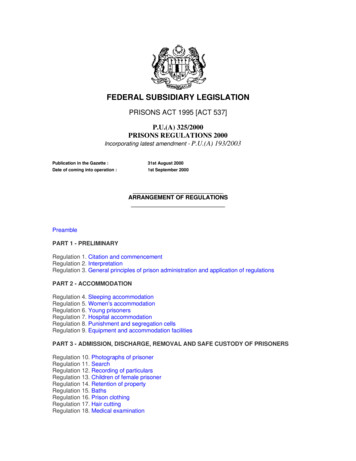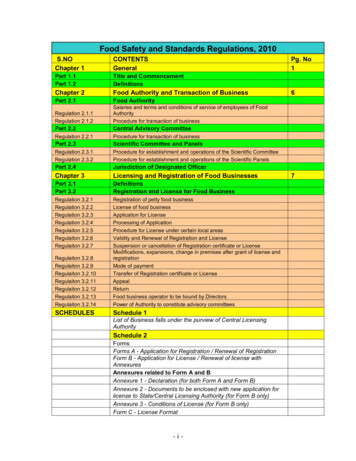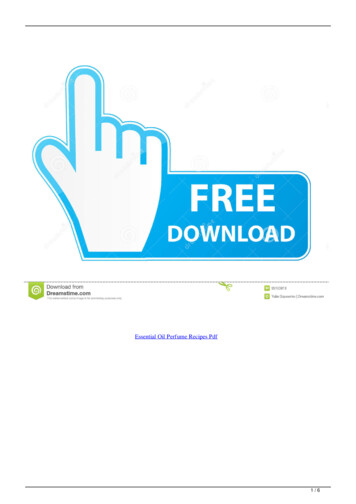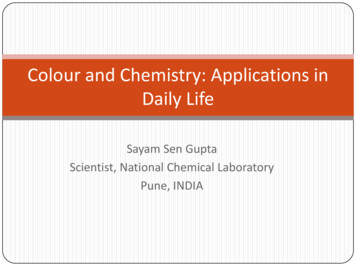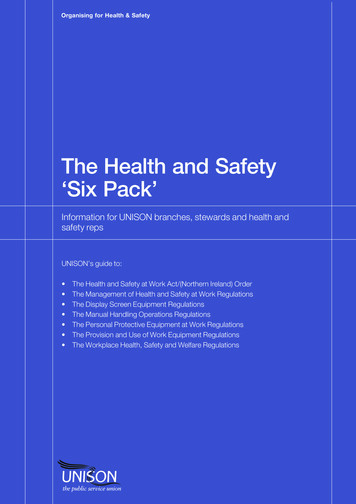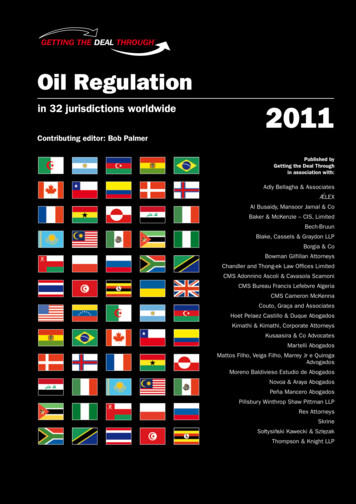
Transcription
Oil Regulationin 32 jurisdictions worldwideContributing editor: Bob Palmer2011Published byGetting the Deal Throughin association with:Adly Bellagha & AssociatesǼLEXAl Busaidy, Mansoor Jamal & CoBaker & McKenzie – CIS, LimitedBech-BruunBlake, Cassels & Graydon LLPBorgia & CoBowman Gilfillan AttorneysChandler and Thong-ek Law Offices LimitedCMS Adonnino Ascoli & Cavasola ScamoniCMS Bureau Francis Lefebvre AlgeriaCMS Cameron McKennaCouto, Graça and AssociatesHoet Pelaez Castillo & Duque AbogadosKimathi & Kimathi, Corporate AttorneysKusaasira & Co AdvocatesMartelli AbogadosMattos Filho, Veiga Filho, Marrey Jr e QuirogaAdvogadosMoreno Baldivieso Estudio de AbogadosNovoa & Araya AbogadosPeña Mancero AbogadosPillsbury Winthrop Shaw Pittman LLPRex AttorneysSkrineSołtysiński Kawecki & Szle zakThompson & Knight LLP
contents Oil Regulation 2011Algeria Samir Sayah CMS Bureau Francis Lefebvre Algeria3Contributing editor:Bob PalmerCMS Cameron McKennaArgentina Hugo C Martelli Martelli Abogados8Azerbaijan Aykhan Asadov and Mahmud Yusifli Baker & McKenzie – CIS, Limited14Business development managersAlan LeeGeorge IngledewRobyn HetheringtonDan WhiteBolivia Luis Moreno Gutiérrez Moreno Baldivieso Estudio de Abogados19Brazil Giovani Loss Mattos Filho, Veiga Filho, Marrey Jr e Quiroga Advogados24Canada Dufferin Harper and Julia Hughes Blake, Cassels & Graydon LLP30Chile Álvaro Araya and Matías Novoa M Novoa & Araya Abogados37Colombia Gabriela Mancero and Milton Montoya Peña Mancero Abogados44Marketing assistantsWilliam BentleySarah SavageDenmark Per Hemmer, Johan Weihe and Rania Kassis Bech-Bruun50Faroe Islands Per Hemmer, Johan Weihe and Rania Kassis Bech-Bruun56Subscriptions managerNadine ance Denis Borgia Borgia & Co62Ghana Kimathi Kuenyehia, Sr and Ernest Kusi Kimathi & Kimathi, Corporate Attorneys66Greenland Per Hemmer, Johan Weihe and Rania Kassis Bech-Bruun73Iraq Bob Palmer and Hussain Kubba CMS Cameron McKenna80Italy Pietro Cavasola and Matteo Ciminelli CMS Adonnino Ascoli & Cavasola Scamoni86Kazakhstan Azamat Kuatbekov and Nurgul Abdreyeva Baker & McKenzie – CIS, Limited93Malaysia Faizah Jamaludin Skrine98Marketing managersEllie NotleySarah WalshAlice HazardAssistant editorAdam MyersEditorial assistantLydia GergesSenior production editorJonathan CowieChief subeditorJonathan AllenSubeditorsCaroline RawsonDavet HylandEditor-in-chiefCallum CampbellPublisherRichard DaveyOil Regulation 2011Published byLaw Business Research Ltd87 Lancaster RoadLondon, W11 1QQ, UKTel: 44 20 7908 1188Fax: 44 20 7229 6910 Law Business Research Ltd 2011No photocopying: copyright licencesdo not apply.ISSN 1744-0939The information provided in thispublication is general and may not applyin a specific situation. Legal advice shouldalways be sought before taking any legalaction based on the information provided.This information is not intended tocreate, nor does receipt of it constitute, alawyer–client relationship. The publishersand authors accept no responsibility forany acts or omissions contained herein.Although the information provided isaccurate as of June 2011, be advisedthat this is a developing area.Printed and distributed byEncompass Print SolutionsTel: 0844 2480 112LawBusinessResearchMexico Gabriel Ruiz Rocha Thompson & Knight LLP104Mozambique Pedro Couto and Taciana Peão Lopes Couto, Graça and Associates110Nigeria Soji Awogbade, Sina Sipasi and Gloria Iroegbunam ǼLEX115Oman Rory Gilchrist Al Busaidy, Mansoor Jamal & Co120Poland Krzysztof Cichocki and Tomasz Młodawski Sołtysiński Kawecki & Szle zak125Russia Alexey Frolov and Alexander Gomonov Baker & McKenzie – CIS, Limited132South Africa Megan Rodgers and Barrisford Petersen Bowman Gilfillan Attorneys136Tanzania Alex T Nguluma Rex Attorneys143Thailand Albert T Chandler and Stefan Chapman Chandler and Thong-ek Law Offices Limited 148Tunisia Adly Bellagha Adly Bellagha & Associates153Uganda Denis Kusaasira and Henry A Kaliisa Kusaasira & Co Advocates157Ukraine Svitlana Romanova and Taras Aleshko Baker & McKenzie – CIS, Limited163United Kingdom Bob Palmer and Matthew Culver CMS Cameron McKenna170United States Robert A James, Joseph H Fagan and Stella PulmanPillsbury Winthrop Shaw Pittman LLP178Venezuela Miguel Rivero and Patrick Petzall Hoet Pelaez Castillo & Duque Abogados187
Bech-BruunGREENLANDGreenlandPer Hemmer, Johan Weihe and Rania KassisBech-BruunGeneral1Describe, in general terms, the key commercial aspects of the oilsector in your country.Greenland is the world’s largest island. Its land area is 2.2 millionkm2, but 1.8 million km2 are covered by the Greenland ice sheet. Thenorthernmost extremity of Greenland is Cape Morris Jessup whichis also the northernmost land area in the world, situated less than730km from the North Pole. Greenland has a population of 56,000inhabitants.Greenland is an autonomous part of the Kingdom of Denmark(the ‘Community of the Realm’) which comprises Denmark proper,Greenland and the Faroe Islands (an island group situated about halfway between Scotland and Iceland).Greenland had home rule from 1979 to 21 June 2009 when itobtained self-government after a referendum and negotiations withthe Danish government. The Danish Act No. 473 of 19 May 2009on Greenland Self-Government entered into force on 21 June 2009.Greenland has extensive self-government under the act, which for mostareas of government either transferred or provides for the transfer ofthe legislative power from the Danish parliament to the Greenlandparliament (Inatsisartut) and the executive power from the Danishgovernment to the Greenland government (Naalakkersuisut).As part of its self-government, Greenland owns and has the rightof disposal of all mineral resources, including oil and gas, in its land,territorial sea and continental shelf areas. Under the Greenland SelfGovernment Act, it may determine that all legislative and executivepowers in the mineral resources area including oil and natural gasshall be transferred from the Danish state. The transfer was decidedby the Greenland Parliament on 23 October 2009 and became effective on 1 January 2010. In connection with the transfer of powers,the former Danish Act on Mineral Resources in Greenland – whichregulated prospecting, exploration and exploitation of oil, gas andminerals – was repealed and replaced by the present Greenland Parliament Act No. 7 of 7 December 2009 on Mineral Resources andActivities of Importance Thereto (Mineral Resources Act). The mainprovisions on oil and gas licences in the present Greenland mineralresources act are based on and correspond to the provisions on suchlicences in the former Danish Mineral Resources Act. All prospecting, exploration and exploitation licences granted under the formerDanish act are still effective but are now governed by the presentGreenland act (see section 98(4)).Exploration for oil and gas began in the early 1970s in areasoffshore West Greenland. Comprehensive seismic surveys were carried out, and almost 21,000 line kilometres of reflection seismic datawere acquired. In 1976 and 1977, five exploratory wells were drilled.Exploration was discontinued in late 1978. All wells were declareddry by the operators. But in 1997, the Geological Survey of Denmarkand Greenland (GEUS) began to carry out re-investigations of thewell data and found that they suggested a hydrocarbon discovery inthe Kângamiut-1 well.www.gettingthedealthrough.comA licensing round for areas offshore West Greenland was heldin 1992 to 1993. As no applications were submitted, an open-doorlicensing policy was introduced in 1994. It covered both onshore andoffshore areas south of 70 30’N in West Greenland and JamesonLand in East Greenland.Subsequent investigations were carried out by Nunaoil – a company then owned jointly by Greenland under home rule and theDanish state and now owned by Greenland as part of its self-government. The investigations confirmed the existence of cross-cuttingreflectors (CCR’s). Based on these discoveries, a licence was awardedin 1996 to a consortium consisting of Statoil, Phillips Petroleum,DONG and Nunaoil. In 1998, a new licence was awarded to thesame participants.Licensing rounds were held in 2001, 2002, 2004, 2006 and 2007.In April 2008, an open-door licensing procedure was launched. Itcovered offshore areas in West Greenland and around Cape Farewell,the southernmost extent of Greenland. On 1 January 2010, it wassucceeded by an open-door licensing procedure under the presentGreenland Mineral Resources Act. The 2010 open-door licensingprocedure covers offshore areas in the southern part of West Greenland and around Cape Farewell and onshore areas in Jameson Landin East Greenland.In October 2009, the Greenland government issued an invitationto apply for licences for exploration and exploitation of oil and gasin two licensing rounds: the Baffin Bay Licensing Round 2010 coversoffshore areas of 151,358km2 in West Greenland. The areas are threetimes the area of Denmark proper. The areas have been divided into14 blocks of sizes between 8,000km2 and 15,000km2. By the application deadline on 1 May 2010, the Bureau of Minerals and Petroleumhad received 17 applications from 12 international oil companies,including some of the world’s major oil companies.The Greenland Sea Licensing Round 2012-13 covers offshoreareas of 50,000km2 in East Greenland. Companies which are members of the Kanumas Group (Statoil, BP, Esso, Chevron, Shell, JOGMEC and Nunaoil) may submit applications for licences in a specialpre-round no later than 15 December 2012. The pre-round coversareas of 30,000km2 designated by the Greenland government in theordinary round area of 50,000km2. After licences have been grantedin the pre-round, any company may submit applications for licencesin the remaining parts of the ordinary round areas in a subsequentordinary licence round. The deadline for submission is 15 October2013.So far the exploration activities have not led the licensees toinitiate any exploitation (production) activities and many parts ofthe Greenland continental shelf area remain relatively unexplored.Exploration for oil and gas has increased considerably in recent years,and a large number of licences for exploration and exploitation ofoil and gas have been granted. On 1 February 2011, an offshorearea of approximately 200,000km2 (approximately five times thesize of Denmark proper) was covered by hydrocarbon explorationand exploitation licences.73
GREENLANDAs of 1 February 2011, 20 hydrocarbon exploration and exploitation licences and 25 hydrocarbon prospecting licences were inforce. Operators for the exploration and exploitation licences are:EnCana Corporation (two licences), Husky Oil Operations (twolicences), DONG, Esso Exploration Greenland, Capricon GreenlandExploration (nine licences), PA Resources, ConocoPhilips, Shell (twolicences), and Maersk Oil. Other participants in these licences areChevron, Statoil, GDF Suez and Nunaoil. Operators for the prospecting licences are Geophysical Service, Norsk Hydro, Cambridge ArcticShelf programme (two licences), Husky Oil Operations, TGSNOPECGeophysical Company (three licences), Cairn Energy, GreenlandResources Company (two licences), StatoilHydro (two licences),GX Technology (three licences), DONG Energy, PGS Offshore,Capricorn Greenland Exploration (two licences), EnCana Corporation, Esso Exploration, Western Geco, PA Resources, NorwegianEnergy Company, Spectrum Geo, and Statoil. Other participants inthese licences are BP, Chevron, Shell, JOGMEC, ExxonMobile andNunaoil.International oil companies from Europe, the United Statesand Canada have thus been granted offshore oil and gas licences inGreenland. These companies are interested in oil and gas exploration and exploitation in Greenland for a number of reasons, one ofthem probably being the assessments of the petroleum potential inboth West and East Greenland made by the US Geological Survey(USGS). For example, one assessment was issued in 2007 (Fact Sheet2007-3077, August 2007) when the USGS completed an assessmentof the potential for undiscovered, technically recoverable oil and gasresources in the East Greenland Rift Basins Province. The USGS estimated the mean undiscovered, conventional petroleum resources inthat province to be approximately 31,400 Mboe (million barrels ofoil equivalent) of oil, gas and natural gas liquids.2What percentage of your country’s energy needs is covered, directlyor indirectly, by oil as opposed to gas, electricity, nuclear or nonconventional sources? What percentage of the petroleum productneeds of your country is supplied with domestic production? What areyour country’s energy demand and supply trends, especially as theyaffect crude oil usage?In 2009, Greenland consumed 9,013 terajoules (TJ) of energy. Elevenper cent of the consumed energy was domestically produced sustainable energy, mainly from hydropower and waste incineration plants.A fourth hydro power plant located in Sisimiut has begun operationsin 2010.From 2008 to 2009, the consumption of petroleum-based fuels(petrol (gasoline), diesel and other fuel oils) decreased by approximately 8 per cent from 8,685TJ to 8,018TJ – equivalent to anincrease from 260 million litres to 240 million litres. This meansthat 89 per cent of Greenland’s energy requirements were coveredby petroleum-based fuels.All petroleum-based fuels used in Greenland are at present supplied by foreign sources.3Does your country have an overarching policy regarding oil-relatedactivities or a general energy policy?The Greenland government and its Bureau of Minerals and Petroleum apply some general policy principles for activities concerninghydrocarbon (oil and gas) and mineral resources. The main objectives of the policy are to establish and maintain an attractive environment for prospecting, exploration and exploitation activitiesconcerning hydrocarbon and other mineral resources in Greenland.Interests of oil and mineral companies are catered for in various waysand respects.A proper, effective and stable hydrocarbon regulation – to someextent similar to the Danish regulation – is established by the mineralresources act and the model terms for hydrocarbon licences.74Bech-BruunThe general policy principles governing prospecting, explorationand exploitation of mineral resources, including oil, are stated insection 1 of the Mineral Resources Act. The purpose of the act is toensure appropriate exploitation of mineral resources and use of thesubsoil for storage or purposes relating to mineral resource activities. The act shall also ensure an appropriate regulation of mattersof importance to mineral resource activities and subsoil activities.The act further aims to ensure that activities under the act are performed properly as regards safety, health, the environment, resourceexploitation and social sustainability as well as appropriately and inaccordance with acknowledged best international practices undersimilar conditions.The Greenland government and a single government authority,the Bureau of Minerals and Petroleum, are responsible for all mainlegal and administrative matters concerning prospecting, exploration and exploitation of mineral resources, including hydrocarbon(oil and gas). This ‘one-stop-shop’ administration is user-friendly foroil companies and supports an administration based on overall andintegrated assessments, decisions and actions.The Greenland government and its Bureau of Minerals and Petroleum have not published an official hydrocarbon or energy policy.Regulation overview4Describe the key laws and regulations that make up the general legalframework regulating oil activities?The Greenland regulatory regime for oil activities, including in particular the Mineral Resources Act, covers the Greenland land, territorial sea and continental shelf areas.The main statutory rules regarding prospecting, explorationand exploitation (production) of oil are laid down in the MineralResources Act. Its part 4 (section 15) contains general rules on prospecting regarding oil, gas and minerals. Part 5 (sections 16 to 21)contains general rules on exploration and exploitation (production)of oil, gas and minerals. Part 6 of the act contains special rules onexploration and exploitation (production) of hydrocarbon (oil andgas).The Mineral Resources Act contains rules on the granting, termsand effects of licences for prospecting, exploration and exploitation,on activities under such licences and on approval and supervision ofsuch activities. The act also sets out requirements in order to ensurethat activities under licences are performed properly as regards safety,health, the environment, resource exploitation and social sustainability as well as appropriately and in accordance with acknowledged best international practices for such activities under similarconditions. The main overall purpose of the act is to support andensure proper and effective exploration and exploitation of mineralresources, including oil and gas, and use of the subsoil for storageor purposes relating to mineral resource activities. The act shall alsosupport and ensure an appropriate regulation of matters of importance to mineral resource activities and subsoil activities.Under the provisions of the act, the Greenland government hasissued government order No. 24 of 30 December 2003 on reimbursement of expenses in connection with administration concerning mineral resource activities (‘reimbursement order’). The orderapplies when it is provided in a licence that the licensee shall reimburse expenses in connection with administration, including supervision, concerning mineral resource activities under the licence. Thereimbursement requirements cover such expenses of the Greenlandgovernment and the Bureau of Minerals and Petroleum, includingexpenses in connection with use of external advisers and service providers (irrespective of whether they are employed in another governmental agency or public institution or are professional (private)advisers or service providers).Other main parts of the regulation concerning prospecting,exploration and exploitation (production) of oil are set out in theGetting the Deal Through – Oil Regulation 2011
Bech-BruunGreenland government’s licence terms (which are issued pursuant tothe Mineral Resources Act): standard terms for prospecting licences – hydrocarbons (March2009); model licence for exploration and exploitation of hydrocarbons– open door areas in Greenland (January 2010); model licence for exploration and exploitation of hydrocarbons in an offshore area in North West Greenland – the BaffinBay Licensing Round (October 2009, licensing round is held in2010); and model licence for exploration and exploitation of hydrocarbonsin an offshore area in North East Greenland – the Greenland SeaLicensing Round 2012-13 (October 2009, licensing round willbe held in 2012 to 2013).Companies that are co-licensees – members of a licence group – mustmake and use a joint operating agreement (JOA) which is subject toapproval of the Bureau of Minerals and Petroleum. The Greenlandgovernment has issued a model joint operation agreement which generally must be used with only minor amendments.The standard terms for prospecting licences, the model exploration and exploitation licences and the model JOA are all available atthe website of the Bureau of Minerals and Petroleum: www.bmp.gl.Prospecting, exploration and exploitation of hydrocarbon (oiland gas) in Greenland may only be carried out under licences grantedby the Greenland government. This follows from sections 2, 15, 16and 22 of the Mineral Resources Act.Prospecting, exploration and exploitation licences are generally granted as hydrocarbon licences which cover both oil and gas.Prospecting licences are non-exclusive. Exploration and exploitationlicences are exclusive.The general selection criteria for granting exploration andexploitation licences are the company’s technical capability and experience; financial capability; and intended exploration and exploitation activities (including its environmental protection practice andprocedures).Pursuant to the Mineral Resources Act and the various licenceterms, licensees must pay certain fees. As mentioned below in question 12, licensees under exploitation licences must also pay a ‘surplusroyalty’ to the Greenland government. And Nunaoil A/S, owned bythe Greenland government, is a mandatory participant in any hydrocarbon exploration and exploitation licence – with a participatinginterest between 8 per cent and 12.5 per cent and a ‘carried’ interestduring the exploration period.5Identify and describe the government regulatory and oversight bodiesprincipally responsible for regulating oil activities.The Greenland government is generally responsible for all legaland administrative matters concerning prospecting, explorationand exploitation (production) of oil, storage of exploited oil andestablishment and operation of oil pipelines for transportation ofoil in connection with the said other activities governed by the Mineral Resources Act. All these activities are governed by the MineralResources Act.Prospecting, exploration and exploitation licences may only begranted, amended and revoked by the Greenland government whichalso must approve any direct or indirect transfer of a licence or ashare of (participating interest in) a licence.Administration of the Mineral Resources Act and all activitiesunder it is generally carried out by the Bureau of Minerals and Petroleum under the Greenland government.The Bureau of Minerals and Petroleum approves activities underprospecting, exploration and exploitation licences (to the extentapproval is required), licensees’ provision of security for performanceof their obligations, and plans for exploration, drilling, exploitation(production) and de-commissioning. In cooperation with the Greenwww.gettingthedealthrough.comGREENLANDland minister of mineral resources, the Bureau of Minerals and Petroleum also approves appointments of operators and environmentalimpact assessment reports. Furthermore, the Bureau of Minerals andPetroleum supervises and inspects activities under licences and otheractivities covered by the Mineral Resources Act.6How does your country manage appeals of government regulatorydecisions?Administrative and regulatory decisions of the Bureau of Mineralsand Petroleum may be appealed to the Greenland minister of mineralresources. Administrative and regulatory decisions of the minister ofmineral resources cannot be appealed to any other public authority.Decisions of the Bureau of Minerals and Petroleum and the minister may be brought before Greenland courts which may revoke oramend such decisions.7What standards are employed for oil measurement and oil facilityequipment? Are these voluntary or involuntary? Are they establishedby a government body?Standards for measurements of oil exploited (produced) in Greenlandmay be laid down by the Greenland government under the MineralResources Act and are to some extent set out in the model exploration and exploitation licences and their appendices with accountingprinciples. These standards may not be disregarded or departed fromby contract.Oil facility equipment used in connection with exploitation (production) or connected storage or transport of oil must be in accordance with the Mineral Resources Act and rules laid down by theGreenland government under the act. The act provides that a licenseemust carry out activities under the licence properly as regards safety,health, the environment, resource exploitation and social sustainability as well as appropriately and in accordance with acknowledgedbest international practices for such activities under similar conditions. These general requirements also apply to oil facility equipment.More specific requirements are set out in the model licences andjoint operating agreements. These requirements may generally notbe disregarded or excluded by agreement.8What government body maintains oil production, export and importstatistics?The Bureau of Minerals and Petroleum is responsible for compilingand keeping information provided by licensees in connection withprospecting, exploration, exploitation (production) and subsequentexport of mineral resources, including oil.In connection with this, the Bureau of Minerals and Petroleum willalso make and keep statistics regarding oil production and export.Greenland Statistics maintains statistics on oil import and energyconsumption. Greenland Statistics is an independent institutionunder the Greenland finance minister.Natural resources9Who holds title over oil reservoirs? To what extent are mineral rightson private and public lands involved? Is there a legal distinctionbetween surface rights and subsurface mineral rights?As part of its self-government, established by the Danish Act No. 473of 12 June 2009 on Greenland Self-Government, Greenland ownsand has the right of disposal of all mineral resources, including oiland gas, within its land, territorial sea and continental shelf areas.Under the Mineral Resources Act, prospecting, exploration andexploitation (production) of all mineral resources, including oil andgas, in Greenland may only be carried out under licences granted bythe Greenland government.75
GREENLANDBech-BruunAn exploitation licence only allows the licensee to exploit andsell or use the covered mineral resources, for example oil and gas.The licence does not grant any kind of ownership or other similarlegal title over the covered mineral resources (until exploited) or thecovered licence area.There is no legal distinction between surface mineral rights andsubsurface mineral rights under the Mineral Resources Act.An exploration licence will be extended as an exploitation (production) licence with a purpose of exploitation if the licensee hascomplied with the terms of the exploration licence, including therequirement to demonstrate a commercially exploitable depositwhich the licensee intends to exploit. The licence periods for exploitation licences are generally 30 years, but may be extended up to 50years if justified by special circumstances.10 What is the general character of oil exploration and production activityconducted in your country? Are areas off-limits to exploration andproduction?14 For offshore production, how far seaward does the regulatory regimeextend?Oil activities, including prospecting, exploration and exploitation(production) may be conducted both onshore and offshore. Currently there are only oil activities offshore.Onshore oil activities will naturally be more difficult in thosemajor parts of Greenland which are covered by the Greenland icesheet. The ice sheet covers 1.8 million km2 of the total land area of2.2 million km2.Some minor areas in Greenland are off-limits for oil activities dueto environmental or military purposes.11 What government body regulates oil exploration and production in yourcountry? What is the character of that regulation?As mentioned above in question 9, prospecting, exploration andexploitation of oil may only be carried out under licences granted bythe Greenland government.The responsible government authorities and the general regulation of licences are described above in questions 4 and 5, and belowin questions 12 to 17.12 If royalties are paid, what are the royalty rates? Are they fixed? Do theydiffer between onshore and offshore production?Pursuant to the Mineral Resources Act, licences for exploitation(production) of oil and gas may contain provisions on payment of a‘surplus royalty’. This is a payment to the Greenland government ofan amount equal to a specific share of the licensee’s profit from theactivities under the licence.Under the Mineral Resources Act and the terms of exploitationlicences, licensees must pay certain fees and a surplus royalty to theGreenland government. Comprehensive provisions on calculationand payment of the surplus royalty are set out in the licences andtheir appendices containing accounting principles.Nunaoil A/S – a Greenland public limited company owned by theGreenland government – is a mandatory participant in any hydrocarbon exploration and exploitation licence. Nunaoil’s share of alicence is set out in the licence and varies between 8 per cent and12.5 per cent. The participating interest of Nunaoil in an exploration licence is ‘carried’. This means that Nunaoil’s share of costs,expenses, obligations and liabilities under the licence is borne solelyby the other participants in the licence. If an exploration licence isextended as an exploitation licence, Nunaoil’s participating interestis no longer ‘carried’.There is generally no difference between onshore and offshoreexploitation of oil and gas as regards fees, surplus royalties and themandatory participation of Nunaoil with carried interest during theexploration period.13 What is the customary duration of oil leases, concessions or licences?Prospecting licences are granted for periods of up to five years at atime. Licence periods for exploration licences are generally 10 years,but may be up to 16 years if justified by special circumstances. Anexploration licence period may be extended by periods of up to threeyears at a time with a purpose of further exploration.76The Greenland regulatory regime for oil and gas exploitation (production) activities, including in particular the Mineral ResourcesAct, covers the Greenland land, territorial sea and continental shelfareas.15 Who may perform exploration and production activities? What criteriaand procedures apply in selecting such entities?Any Greenland or foreign person or company may perform oil prospecting or exploration activities under a prospecting licence or anexploration licence, respectively, if the requirements for licensees andoperators under such licences are met.Under section 16(3) of the Mineral Resources Act, an exploitation (production) licence may only be granted to a public l
Greenland Per Hemmer, Johan Weihe and Rania Kassis Bech-Bruun 73 Iraq Bob Palmer and Hussain Kubba CMS Cameron McKenna 80 . Oil Regulation 2011 Published by Law Busi

